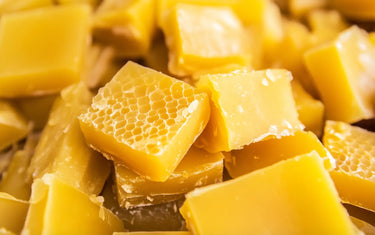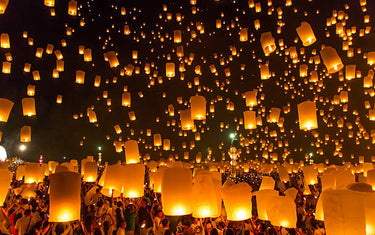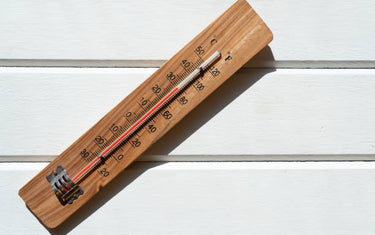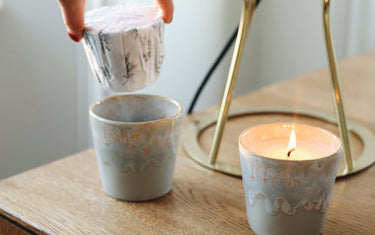5 min read / 19 May 2023 / Laura Garvin Gomez
What Are Candles Made Of?
Wax is the ingredient at the heart of every candle, but what exactly is wax, and what is it made from?
Share this post

Every good candle starts with a good wax base.
For beginners and seasoned candle makers alike, there's nothing more integral for scented candle success than steady wax with a good scent throw and a solid burn time. The more candles you make though, the more tempting it is to wonder; how is wax made?
If you're someone who values sustainability in your crafting, learning what's inside the chemical makeup of your wax can determine what kind of environmental impact it will have. This is a key step in deciding whether or not it's the right wax for you.
So, if you're feeling a little lost in choosing your wax, or you simply want some more insight into the world of candle making, we're detailing all the facts you need to know.
Where does candle wax come from?
We all know about its importance in our candles, but where does wax come from? Did it just suddenly show up one day with a vow to make our homes smell great? Well no, not exactly.
Candles have been around for centuries, with the earliest surviving versions dating all the way back to 200 BC in Han, China.
Initially, these candles were made using whale fat. In other regions, this would be substituted with "tallow wax" which was made using the meat of cows and sheep.
These days, candle wax is (thankfully) produced without the flesh of animals, but it's still important to know exactly what goes into the wax types we pick.
What is candle wax made of?
In the modern day, there are three distinctive wax types you'll come across: soy, paraffin, and beeswax. All three have different chemical backgrounds, and all are formed in different ways.
There are pros and cons for every kind of wax out there, so we're running through the details of each type to help you make an informed decision for your crafts.
Paraffin wax
Paraffin wax is the cheapest and most widely available wax type on the market. Most commercially produced candles will use paraffin wax as their base, thanks to its ability to hold both dyes and scents very well for a minimal cost.
Paraffin wax is a by-product of the petroleum industry, created using waxy substances from crude oil. As crude oil is a fossil fuel, paraffin wax is neither biodegradable nor natural. This means a lot of candle makers tend to stay away from it for environmental reasons.
Candles made using paraffin wax are also known for releasing soot and toxins into the air - including two carcinogens that have been linked to the development of cancer.
Its impact on both health and sustainability has meant that candles using paraffin wax are (gradually) limiting in production.
Soy wax
Due to the many issues surrounding paraffin wax, many candle makers are now opting for the use of soy wax instead.
Soy wax is a vegetable wax made purely from the extracted oils of soybeans. The beans are cleaned, cracked, de-hulled, and rolled into flakes before they're ready for extraction.
Soy wax has soared in popularity not only for its all-natural production but also for its lack of expense, clean burn, and wide availability. Soy wax can burn up to 50% longer than paraffin wax and is an excellent scent carrier, without the need for additional additives or amplifiers.
These benefits mean candle makers get more value for their money and greater customer satisfaction as a result.
Beeswax
Beeswax is one of the oldest remaining wax types on the market. Made from the waxy abdominal secretions of honeybees, beeswax is another all-natural alternative to paraffin, but with a much heftier price tag.
Beeswax is used by honeybees to help build their honeycomb hives. Often, beeswax will be extracted at the same time as honey and is considered a by-product of the industry.
Because of its natural background, beeswax can range in colour from white to yellow, orange, red, or even brown. Like honey, beeswax has a naturally sweet but pleasing aroma.
Some candle makers like using beeswax as a unique selling point, but others can feel disheartened by the expense. The colour of beeswax can also make it very hard to dye.

What other types of wax are available?
While there are other wax types you can use in your candles, these are less common and therefore less readily available.
In the interest of answering the question "what are candles made of" though, we'll be touching on the origins of these wax variations too.
Coconut wax
Just like coconut oil, coconut wax has become a worthy addition to the wellness world in recent years.
All-natural with a slow, clean burn, coconut wax contains a subtle sweetness that tends to work well with other fragrances. It also emits very little soot and is a good choice from a sustainability perspective.
While it's not as popular as soy wax or even beeswax, its natural credentials mean we could be seeing more of this wax type yet.
Gel wax
Interestingly, gel wax isn't really wax at all. Instead, it's a transparent, rubbery compound made out of polymer resin and mineral oil.
The benefit of gel wax is mainly for the creation of transparent candles, which often feature colourful additions like sand or glitter. This wax type offers a unique product and tends to hold both scents and dyes with reasonable ease.
It does, however, get very hot and poses a greater risk of accidents like explosions or breakages. Fragrance oils are also not always gel-safe, which limits the type of scent you can use in your candle.
Palm wax
Once upon a time, palm wax was a very popular, plant-based alternative to paraffin wax. Long-lasting with a clean burn and low soot, palm wax had the potential to become as popular as soy wax is today.
Since the news broke about the effects of palm oil on deforestation, however, sales for palm wax and other palm products have majorly declined.
Most candle makers now completely boycott this wax type, and instead prioritise fully sustainable options that do not cause any harm or devastation to our ecosystem.

So, there you have it. All the possible wax varieties that candles can be made from.
From natural waxes to quirky gimmick gels and questionable by-products, the wax you choose will really identify what you, as a candle maker, stand for. This may seem like a lot of pressure, but ultimately the decision will come fairly naturally to you and what works best for your brand.
If you've chosen your wax, but still need some help on what to do with it, you can refer to our wax melting guide for more information.









